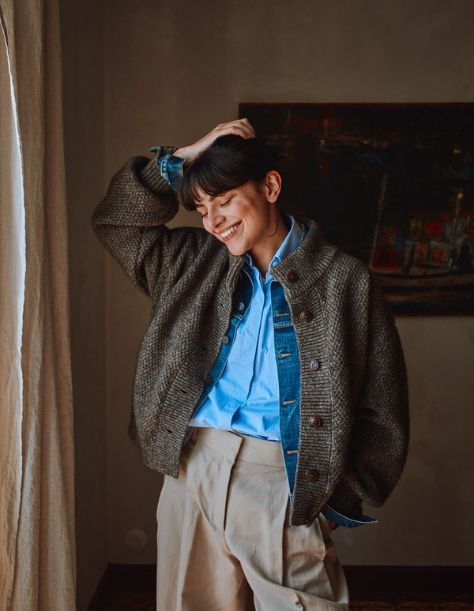HOW TO STYLE SUSTAINABLE FASHION?

Building a sustainable wardrobe is more than a style choice – it’s a commitment to the planet and a reflection of personal values. The fast fashion industry has a heavy toll on the environment, but with thoughtful decisions, we can contribute to a better future.
At L'Envers, we are committed to the craftsmanship of high-quality clothing created from eco-friendly materials. Our garments are produced ethically and, thanks to their timeless look, they can be worn for years to come.
With this tutorial, we provide you with the most important sustainable fashion tips to help you build a stylish, environmentally friendly, and ethical wardrobe.
Let’s dive in!
1. Build a Capsule Wardrobe with Essentials
Creating a versatile wardrobe embraces the principles of sustainable fashion by emphasizing quality over quantity. This practice emphasizes investing in durable fabric items that can be mixed and matched across multiple outfits.
L’Envers embraces this philosophy with organic cotton and natural wool manufactured to endure seasons of style. A capsule wardrobe not only saves resources but also encourages more mindful shopping habits. This aligns with the principles of the circular economy, focusing on high-quality items over quantity.
2. Opt for Natural and Biodegradable Fabrics
Choosing eco-friendly materials greatly impacts a sustainable fashion journey. For example, natural fibers like yak and merino wool break down naturally, as they need less processing to begin with. By adopting this choice, you protect ecosystems and lower carbon emissions.
Conventional fabrics linger in landfills for decades, while sustainable fabrics decompose faster, leaving a smaller footprint on nature. By choosing biodegradable clothing, you can truly make a difference.
3. Layer for Style and Seasonality
Layering is a simple and fashionable way to get the most out of your wardrobe. It works without buying new clothes for every season. For example, wearing pieces like L’Envers’ sleeveless sweater or grey cable sweater helps you move smoothly from fall to winter. This approach cuts down on seasonal overconsumption.
4. Care for Your Garments Properly
A wise choice in fashion is to keep clothing for many years. With care, worn apparel remains in fine form which reduces the need to be replaced. Washing at cooler temperatures, air-drying, and avoiding harsh detergents are all small but impactful practices. The European Environment Agency highlights that extending the life of clothes by just nine months can reduce carbon, water, and waste footprints by up to 20–30%.
5. Embrace Neutral Colors for Versatility
Neutral shades found in L’Envers’ range of earth-toned hues add a touch of diversity to fashion choices. These hues, like ash grey and cream, offer a range of styling possibilities for effortless mixing and matching that allow you to curate outfits without the need for frequent shopping trips.
For example, the KATRINA Open Weave Cardigan in beige can pair effortlessly with multiple looks, which means you can maintain a smaller, more sustainable wardrobe. By choosing versatile colors, you reduce waste, make eco-friendly choices, and ensure that each piece has a place in your closet, no matter the season.
6. Prioritize Ethical Production and Fair Trade
Buying from brands that focus on ethical production and fair trade is key. At L’Envers, each piece is made to order in family-run workshops in Spain and France. Supporting transparent supply chains fosters safer labor practices and reduces overproduction, one of the biggest causes of waste in the fashion industry.
7. Add Eco-Friendly Accessories
Good news!
Accessories add style to your wardrobe without the need to buy many new things, offering a fast and simple way to change your look. For instance, L'Envers specializes in eco-conscious additions crafted from natural fibers such as wool and cotton. Their selection of hats, scarves, and socks propose simple solutions for fashionable, responsible attire. These items are made from natural fibers and help keep you warm and they’re made with low-impact materials that reduce your carbon footprint.
Therefore, choosing accessories from companies prioritizing planet-friendly and sustainable practices allows you to display your personal style while supporting the reduction of carbon footprints.
8. Explore Second-Hand Stores for Unique Finds
Secondhand stores and vintage shops are like treasure chests-they offer high-quality, unique pieces! These items create a character in your wardrobe while fostering sustainable shopping habits. Buying secondhand reduces waste by giving new life to pre-loved garments and supports a circular economy in which clothes are recycled rather than dumped. If you're in Paris, we can't recommend you enough to visit our friends at Love & Dress for unique pieces and personalized styling recommendations.
It's simple: it's a form of sustainable fashion because it lessens your environmental impact. It involves fewer carbon emissions since you are not contributing to any new production.
Therefore, you contribute positively to the environment while finding one-of-a-kind pieces in your wardrobe-building process by adding second-hand shopping to your repertoire.
9. Look for Low-Impact Materials and Natural Dyes
Materials matter. Organic cotton, hemp, and recycled fibers save water and energy, while natural dyes reduce pollution compared to synthetic chemicals. The United Nations Alliance for Sustainable Fashion emphasizes that innovative low-impact materials are essential to reducing fashion’s environmental burden.
Why L’Envers is Your Partner in Sustainable Fashion
L'Envers stands out in sustainable fashion with its incorporation of eco-friendly and recycled materials, ethical manufacturing, and timeless designs. Choosing L’Envers means supporting a brand that reduces environmental impact while elevating your personal style.
Why Does Sustainable Fashion Matter More Than Ever?
Sustainable fashion is not just a trend—it’s becoming a global necessity. The fashion industry is responsible for nearly 10% of global carbon emissions and produces 20% of the world’s wastewater, according to the United Nations Environment Programme (UNEP). If unchecked, these numbers will continue to grow as global consumption rises.
But what does this mean for the everyday consumer? It means that every purchase has power. By choosing durable, responsibly made garments, you directly reduce demand for fast fashion and its environmentally damaging supply chains. It also means engaging in practices like:
- Repairing instead of replacing: A small mend prevents unnecessary waste.
- Swapping and renting: Platforms like Le Closet or community swap events extend the life of clothing.
- Educating yourself: Resources from NGOs such as Fashion Revolution provide insights into supply chain transparency and ethical consumption.
Moreover, sustainable fashion plays a role in social justice. Workers in low-cost production countries often face unsafe conditions and unfair wages. By supporting ethical brands and secondhand markets, consumers become part of a systemic shift toward fairness.
Finally, there’s the personal benefit: sustainable wardrobes are calmer, less cluttered, and filled only with garments you love and wear. This mirrors the philosophy of “slow living” and promotes mindful consumption.
Transitioning to sustainable fashion is not about perfection—it’s about progress. Even small shifts in consumer behavior can accelerate systemic change. The question is no longer if we should change the way we dress, but how fast we can act to reduce fashion’s footprint.
Embrace Sustainable Fashion with Confidence
Building a sustainable wardrobe requires consideration, from selecting versatile pieces to supporting brands aligned with your values. Each decision becomes part of a ripple effect. By prioritizing quality, transparency, and eco-conscious materials, we collectively push the fashion industry toward a healthier future.
At L’Envers, we remain dedicated to crafting clothes that are designed to be worn, re-worn and passed on—a true antidote to fast fashion.
FAQ
Pair a wool cardigan with jeans, layer a mohair sweater over dresses, and use eco-friendly accessories for effortless outfits.
Yes, sustainable fashion combines timeless design with current trends, proving eco-conscious clothing can be both chic and ethical.
Incorporate versatile knitwear like cardigans or sweaters with your everyday basics to create stylish, eco-friendly looks.
FREE SHIPPING
from 300€ to Europe, from 320€ to North America, UK, Swiss, from 360€ to Asia
FLEXIBLE EXCHANGE AND RETURNS
within 30 days
3-PART PAYMENTS
with SplitIt
CUSTOMER SERVICE
Contact Us for advice and customization


